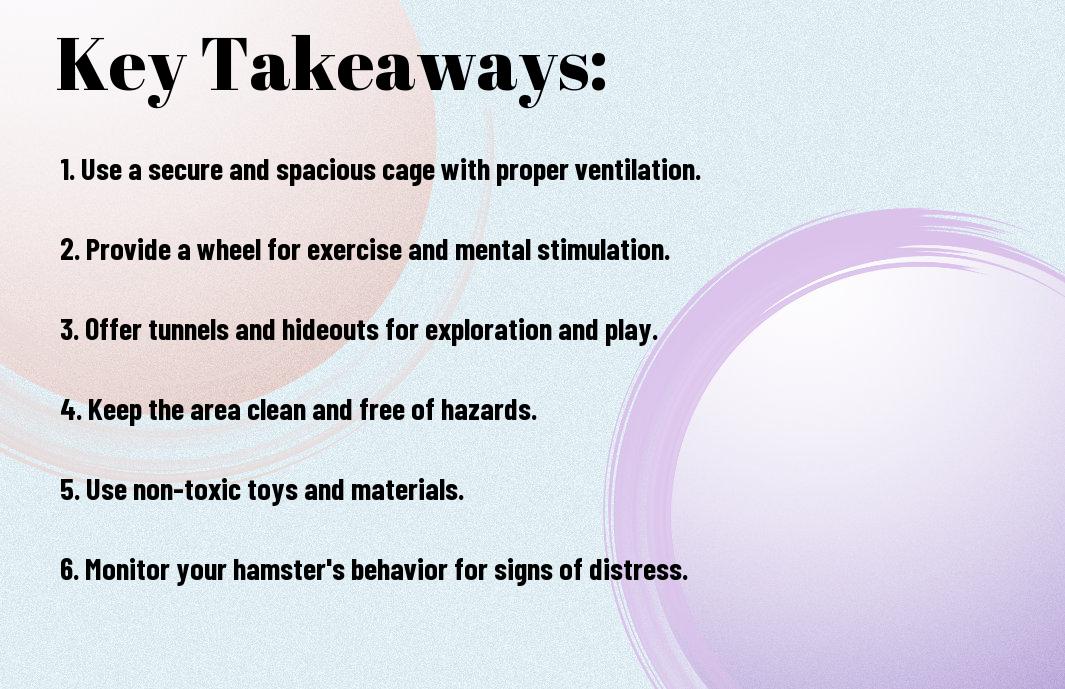Constructing a secure and stimulating exercise area for your beloved hamster is crucial to ensuring its health and happiness. By following these guidelines, you can create an environment that will encourage your pet to stay active and entertained while minimizing potential hazards. From selecting the right accessories to arranging the layout, we will guide you through the process step by step.
Key Takeaways:
- Provide a secure enclosure: Ensure the exercise area is escape-proof with appropriate bedding and a secure lid or cover.
- Include toys and enrichment activities: Offer hamster-safe toys, tunnels, and wheels to keep your pet stimulated and engaged.
- Regularly clean and inspect the area: Keep the exercise space clean and regularly check for any hazards or wear and tear that may pose a risk to your hamster.

Planning Your Hamster’s Exercise Area
If you want to set up a safe and engaging exercise area for your pet hamster, careful planning is essential. Creating the right environment will not only ensure your hamster’s physical and mental well-being, but it will also provide you with the satisfaction of knowing that you are giving your pet the best possible care.
Space Requirements and Location
When planning your hamster’s exercise area, it’s important to consider the space requirements and location. Your hamster’s exercise area should be spacious enough to allow for natural movements such as climbing, running, and burrowing. Ensure that the area is located in a quiet part of the house away from direct sunlight and drafts, as these can be stressful and potentially harmful to your pet’s health.
Essential Equipment for Hamster Fitness
Equipping your hamster’s exercise area with the right accessories is crucial for their physical and mental health. Invest in a solid hamster wheel that is the appropriate size for your pet. Look for a wheel that is solid and does not have gaps that could trap your hamster’s paws. In addition to a wheel, provide your hamster with tunnels, ladders, and platforms for climbing and exploring. Make sure that all equipment is made from non-toxic materials to keep your hamster safe.
Designing a Secure Environment
However, before you let your hamster loose in its exercise area, it’s essential to make sure the environment is secure. You don’t want your pet escaping and getting into any hazardous situations. Here are some tips on designing a safe exercise space for your hamster.
Ensuring Safety within the Exercise Space
When setting up the exercise area for your hamster, you need to ensure there are no potential hazards that could harm your pet. Check for any small openings or gaps where your hamster could escape or get stuck. Look out for cords, wires, or small objects that your hamster could chew on or swallow. Keep the area clear of any harmful chemicals or toxic plants that your pet could come into contact with. Additionally, make sure the exercise area is located in a quiet, low-traffic area, away from other pets or potential disturbances that could stress out your hamster.
Materials and Items to Avoid
Some materials and items can be harmful or even fatal to your hamster if ingested. Avoid using materials such as pine or cedar wood shavings, as they can be toxic to hamsters. Stay away from small plastic toys or objects that your hamster could chew on and swallow, risking injury or obstruction in its digestive system. Lastly, be cautious with any exercise wheels or toys with small parts that could potentially injure your pet.
Stimulating Exercise Activities for Hamsters
Despite their small size, hamsters are active creatures and need regular exercise to maintain their physical and mental well-being. Providing stimulating exercise activities is essential to keep your pet hamster healthy and happy. Here are some great ideas to create a fun and engaging exercise space for your hamster.
Choosing the Right Exercise Wheel
When it comes to exercise wheels for hamsters, the right size and design are crucial for your pet’s safety and comfort. Look for a solid-surface wheel to prevent your hamster’s feet from getting caught in the gaps. The wheel should also be large enough to allow your hamster to run comfortably without arching its back. Avoid wire or mesh wheels as they can cause serious injuries to your hamster’s feet and legs. Additionally, make sure the wheel is securely attached to the cage to prevent it from falling over and injuring your pet.
Tunnels, Bridges, and Climbing Structures
Adding tunnels, bridges, and climbing structures to your hamster’s exercise area can provide endless fun and stimulation. These accessories not only encourage physical activity but also promote mental enrichment for your hamster. You can create a maze-like setup with various tunnels and hideouts to keep your hamster curious and active. Ensure that the materials used are non-toxic and safe for chewing to avoid any health hazards for your pet. Climbing structures such as small ladders, ropes, and bridges offer opportunities for your hamster to explore and exercise its natural climbing instincts.
Ongoing Maintenance of Your Hamster’s Exercise Area
Lastly, it is important to ensure that your hamster’s exercise area is well-maintained and kept clean to provide a safe and healthy environment for your pet. Ongoing maintenance includes regular cleaning and sanitizing of the space, as well as performing regular checks and updates to ensure everything is in good condition.
Cleaning and Sanitizing the Space
When it comes to cleaning and sanitizing your hamster’s exercise area, it is important to establish a regular routine. You should clean the exercise area at least once a week, removing any bedding, leftover food, and waste. Use a pet-safe disinfectant to thoroughly clean the surfaces, toys, and accessories in the area. Make sure to rinse and dry everything completely before putting it back in place. Regular cleaning will help prevent the buildup of bacteria and odor, keeping your hamster healthy and happy.
Regular Checks and Updates
Regular checks and updates are crucial for maintaining a safe exercise area for your hamster. You should inspect the space for any signs of wear and tear, loose or broken components, and potential hazards. Replace any damaged or worn-out items, such as chew toys and exercise wheels, to prevent accidents and injuries. Additionally, check for any escape routes or gaps in the enclosure that could pose a risk to your hamster’s safety. By keeping a close eye on the condition of the exercise area, you can ensure that it remains a secure and enjoyable space for your pet.
Setting Up a Safe and Engaging Exercise Area for Your Pet Hamster
Taking this into account, it is essential to make sure that your pet hamster’s exercise area is safe and engaging. Providing a variety of toys and exercise equipment, along with ensuring that the area is escape-proof and free from hazards, will help keep your hamster entertained and active. Regularly inspecting and maintaining the exercise area will also help prevent potential injuries and ensure your hamster’s well-being. By following these guidelines, you can create a safe and engaging environment that will keep your pet hamster happy and healthy.
FAQ
Q: What should I consider when setting up an exercise area for my pet hamster?
A: When setting up an exercise area for your pet hamster, it’s important to consider the size of the enclosure, the type and amount of exercise equipment, and the safety of the environment. Ensure the exercise area is spacious enough for your hamster to move around comfortably and that it is escape-proof and free from any potential hazards such as sharp objects or toxic substances.
Q: What kind of exercise equipment is suitable for a pet hamster?
A: Suitable exercise equipment for a pet hamster includes a hamster wheel, tunnels, and chew toys. A hamster wheel allows your pet to engage in running activity, while tunnels provide opportunities for exploration and climbing. Chew toys are important for dental health and mental stimulation. It’s essential to choose equipment that is appropriately sized for your hamster and made from safe, non-toxic materials.
Q: How can I ensure my pet hamster’s exercise area is engaging and stimulating?
A: To ensure your pet hamster’s exercise area is engaging and stimulating, consider adding items such as hiding spots, climbing structures, and puzzle toys. Hiding spots, such as small cardboard boxes or ceramic houses, provide security and privacy for your hamster. Climbing structures, such as ramps or platforms, offer opportunities for physical activity and exploration. Puzzle toys, such as treat balls or foraging toys, provide mental stimulation and encourage natural behaviors such as foraging and problem-solving.














